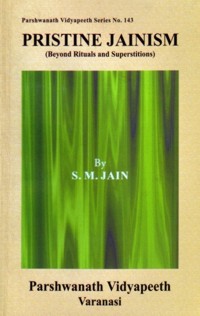In view of the fundamental principles of Jainism it is difficult to substantiate the genesis of the rituals of worship by eight substances viz. water, sandal, source of light (Deepak), incense (Dhup), fruits, flowers, food (Nevedya) unbroken rice (Akshat). So enlightened as Arhats would have never said that their followers should worship them. They tread on ideal, rational path and ordained their followers to follow it to achieve salvation like them. Therefore it is obvious that prescription for worship did not originate from Arhats but was subsequently added by saints who were not omniscient but only mundane beings (chadmasth), probably under the influence of the rituals of other sects. The literary meaning of these eight substances is misleading e.g. sandal is metaphorically metonymical for soothing precepts of Arhats but it is given up in offering during worship whereas in principle it should be imbibed. But the stanzas in worship are different while offering flowers, which incite sexuality (Kam) and should be forsaken. The literary version is correct in case of flowers but not others water etc. The Arhats and Siddhas who are worshiped are free from all wants and passions. They do not, require anything. They are neither pleased by offerings nor angry otherwise. The worship ritual is probably a copy of other sects where gods and goddesses are supposed to be pleased. However, worship though copied has been given connotations according to Jainism for forsaking passions and following righteous path. The offerings are taken by servants (Malis) in temples for their livelihood. But there is no justification for colouring rice etc. because it reduces sale prices and harms the interests of servants. Gandodhak (water from cleaning of idols) is put on head, eyes and other organs by Jains with reverence with false belief that it will cure them or bestow favours. The results may be otherwise as a person with conjunctivitis (eye infection) twice dips his hands, others following him may also get infected with the disease. Devotees even smear their bodies with washings of dirty feet of monks. This is a copy of the practice of taking foot-washings (Charnamrit) in vaishnavite cult. Pouring of water butter, milk etc. on Jain idols (Abhishek) is a common ceremonial practice on various occasions. This is against Jain principles. Bathing ceremony (Abhishek) is done only at the time of the birth of Tirthankaras and not even during their ascetic life much less when they attain godhood (Arhat). The idols once consecrated are to be revered as Arhats and pouring water on these idols is lowering down the status from Arhat to child at birth. This is disrespect to Arhats and is sin. The practice is certainly imitation of vaishnavite cult. Cleaning of idols (Prakshal) as prescribed by squeezed wet cloth is different as it is necessary to clean dust etc. from idols. The practice of putting big brass bells in Jain temples is also imitation of other cults. In other cults the belief is that there gods sleep and have to be awakened. In Jainism the gods Arhats and Siddhas do not sleep and are immune from eighteen weaknesses viz rebirth, aging, thirst, hunger, wonder, anxiety, sorrows, illness, painful thoughts, pride, attachment, fear, sleep, worry and sweating. The argument given for ringing bells loudly is that heavenly beings also come in temples and may be visible to some who may get harmed. This is all wrong as even if heavenly beings come, they are Jain and will not harm Jains. Temples should be places of peace and tranquillity for meditation, people here should recite prayers only silently and not disturb others as disturbing others is sin (Antrai Karma). Ringing bells, singing on microphones or using other instruments loudly cause noise pollution and is harmful to users as well as others. In most of religious congregations, processions and festivals the noise levels are much above 45 decibels, mostly 90 to 120 decibels and are harmful, causing deafness, headaches etc.
Pristine Jainism : Ritual of Worship
Author:
 S.M. Jain
S.M. Jain
 S.M. Jain
S.M. Jain
Published: 10.05.2012
Sources
| Title: | Pristine Jainism (Beyond rituals and superstitions) |
| Publisher: | Parshwanath Vidyapeeth, Varanasi, India |
| by: | Prof. Sagarmal Jain |
| Edition: | 2003 |

Page glossary
Some texts contain footnotes and glossary entries. To distinguish between them, the links have different colors.
Page statistics
This page has been viewed 1159 times.